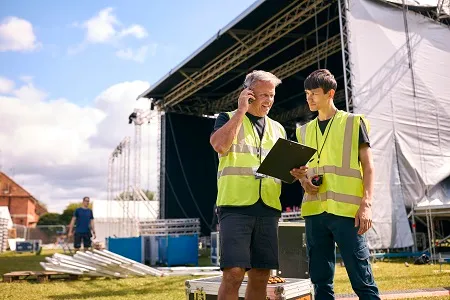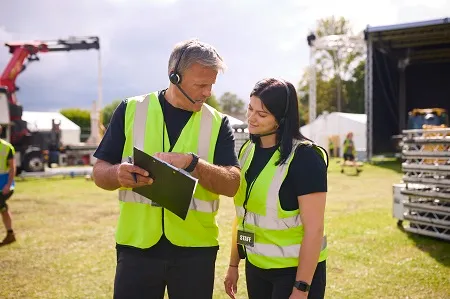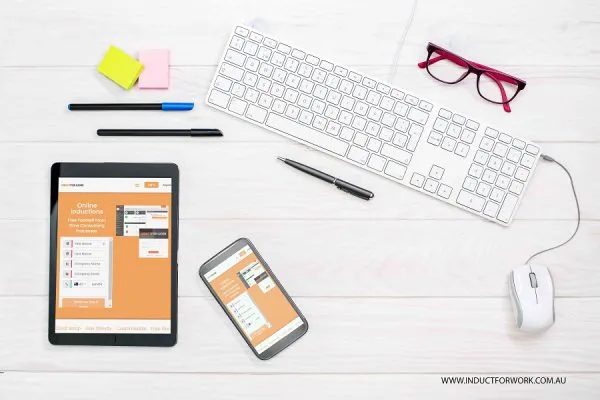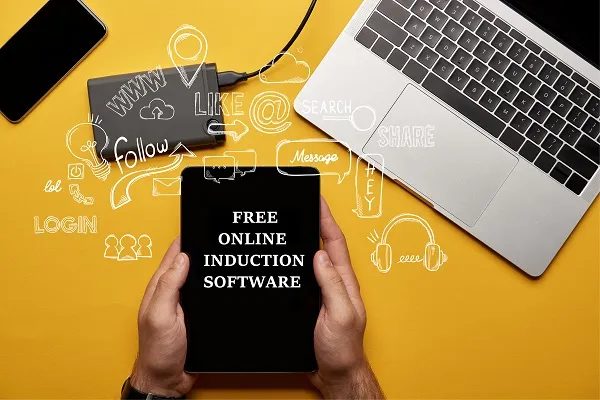Stadiums are small cities that come to life on a timetable. On a match day or during a concert, tens of thousands of people converge on a site that contains plant rooms, catering operations, rigging and lighting gantries, broadcast compounds, retail outlets, loading docks, waste areas and complex crowd-flow corridors. In a typical week, the same venue may swing from quiet maintenance to full-scale operations with hundreds of contractors and volunteers. That variability is exactly why workplace inductions are not a box-ticking exercise for stadiums – they are the frontline of risk control and operational discipline.
Let’s discuss why inductions matter so much in stadium environments and event managers, the tangible benefits of doing them well, and how Induct For Work can help deliver a robust, repeatable system across staff, contractors and event partners.
Why stadiums are different
Most workplaces have relatively stable hazards and a steady workforce. Stadiums don’t. A venue’s risk profile changes with every event and every build. Key complexities include:
High crowd densities and dynamic egress routes. Small procedural lapses can cascade into major safety incidents.
Frequent third-party activity. External crews (riggers, broadcast, hospitality, merch, security, cleaners) rotate constantly, each with different competencies and supervision structures.
Temporary structures and late changes. Staging, pyrotechnics, track covers, hospitality suites, and camera platforms arrive and disappear at speed.
Mixed plant and equipment. Forklifts on concourses, MEWPs in stands, generators, and temporary power—all operating near public areas.
Tight turnaround windows. Inductions must be efficient and verifiable, or work will start before people are competent to be there.
In short: the consequences of poor inductions range from injury and event disruption to reputational damage and regulatory scrutiny. A fit-for-purpose induction system is one of the few controls that touches every worker before they step onto the site.
What a “good” stadium induction achieves
A strong induction program is more than a video and a tick box. It should systematically prepare each person for the specific risks, rules, and workflow of your venue and event. Done right, stadium inductions deliver seven core benefits.
1) Safety, first and always
Inductions set clear expectations about PPE, restricted zones, traffic management, hot-work permits, electrical safety, working-at-heights controls, pyrotechnics handling, and emergency alarms. When every contractor gets the same baseline—and proves they understood it—you reduce the likelihood and severity of incidents.
2) Operational reliability
Stadiums run on choreography: who enters where, when, and with what equipment. Inductions standardise access procedures (e.g., dock check-in, vehicle movements, radio protocols, lift usage windows), which translates into fewer delays and fewer last-minute disputes between crews.
3) Legal and insurance defensibility
When audits or claims occur, evidence matters. A modern induction records consent, policy acceptance, and assessment outcomes against each individual. That audit trail supports your due-diligence story and typically satisfies venue insurers, promoters, and regulators.
4) Contractor control without friction
Most incidents in venues stem from work by third parties. Pre-qualification (insurances, licences, SWMS/RAMS) and event-specific inductions let you gate access until requirements are met—without tying up your safety team in admin.
5) Consistency across events and sites
Templates, version control, and role-based content ensure the steward who starts next Tuesday and the rigger who arrives tonight both receive correct, current instructions—no matter which manager is on duty.
6) Faster onboarding and fewer briefing lines
When the essentials are covered online—before a shift—your on-site briefings can focus on live changes (e.g., a blocked concourse or revised egress route) rather than repeating basic rules.
7) Culture and brand protection
A venue’s reputation travels. Inductions are a practical way to embed your ethos: respectful behaviour, crowd care, sustainability practices (waste streams, noise, light spill), and how to raise issues quickly.

What a stadium-ready induction should include
Below is a checklist stadiums use to shape effective, targeted induction flows.
Role-based modules
General site induction for anyone accessing back-of-house.
Specialist streams: rigging/MEWP, catering and food safety, broadcast operations, merch, cleaners/waste, security/stewards, medical teams, pyrotechnics.
Visitor/VIP access rules for behind-the-scenes tours.
Site-specific hazards and controls
Venue maps with restricted areas, plant rooms, and muster points.
Crowd-flow routes and timings (including lock-downs during ingress/egress).
Traffic management plans for docks and on-pitch movements.
Working-at-heights rules for seating bowls, gantries, and roof walks.
Hot-work and energy isolation permits: how to request and close out.
Temporary power, cable ramping, and weather protocols for open venues.
Behaviour and communication standards
Radio channels and call signs, escalation paths, incident categories.
Code of conduct (harassment, intoxication, betting integrity for sport).
Customer service expectations for visible crews on event day.
Emergency readiness
Alarm tones, PA messages, and responsibilities by role (steward vs. contractor).
Evacuation routes per zone with refuge areas for PRM (persons of reduced mobility).
Specific drills for fire, medical, pitch invasion, severe weather, and structural alarms.
Competency verification
Short assessments (scenario or multiple choice) with minimum pass scores.
Evidence capture: licences, tickets (e.g., IPAF), insurances, and RAMS upload.
Expiry tracking and auto-reminders.
Where digital makes the difference
Paper inductions are slow and impossible to keep current across rotating crews. An online platform should provide:
Pre-event delivery: Send invites by SMS or email; people complete on any device.
Identity and badge: Photo capture, name display and QR code.
Conditional logic: Forklift drivers see different content from hospitality staff.
Multilingual support: Stadium workforces are diverse; language coverage matters.
Records & reporting: Who’s cleared to work today? Whose insurance expires Friday?
Integrations: Door controllers, contractor portals, HRIS or visitor systems.
On-site validation: Scan a QR to confirm induction currency at the gate or dock.
Version control: New module for a pyrotechnics show? Publish and enforce it instantly.

How Induct For Work supports stadiums
Induct For Work (IFW) is designed for real-world venues that need to move fast without losing control. Below are the capabilities and services that matter most in a stadium context.
1) Purpose-built induction flows
Role & site-based modules: Build once; assign by role, contractor or event.
Conditional content: Show specific procedures when a user selects “broadcast,” “rigging,” or “hospitality.”
Assessments & acknowledgements: Set pass marks; require e-signature for policies.
2) Contractor and vendor management
Pre-qualification workflows: Collect insurance certificates, licences, RAMS/SWMS; set approval rules.
Expiry tracking: Automated reminders before documents lapse.
Company-level and individual-level control: Vendors cannot book in unless both are compliant.
3) Easy access and identity on the day
SMS/email invitations reduce friction for itinerant crews.
QR check-in and pass validation at arrival points—ideal for loading docks and back-of-house gates.
Badge printing options (when paired with supported printers) so crews are visibly identifiable.
4) Multilingual delivery
IFW supports 55+ languages, making it practical to deliver critical safety messages to a multi national workforce. Stadiums commonly run English plus two or three additional core languages aligned to their contractor base.
5) Mobile-first
Contractors complete inductions on their phones; supervisors can verify completion even in lower-connectivity back-of-house zones.
6) Event-specific updates
Rapid induction setup and team groupping lets you add a short module for this weekend’s pyrotechnics or a restricted concourse due to refurbishment. Assign it only to the affected teams and make it mandatory before site access.
7) Toolbox talks, incidents and close-out
Beyond induction, IFW supports toolbox talks, incident reporting and site diaries so your venue operations and safety record sit in one ecosystem.
8) Evidence and audits—done
Time-stamped records of every completion, assessment score and document acceptance.
One click to export induction status for promoters, league compliance or insurers.
9) Integrations and portals
Portals for contractors or event partners to manage their teams.
Connect with access control or visitor systems to ensure only inducted people can collect passes or enter work zones.
10) Assisted setup and ongoing support
IFW offers assisted customised setup to get your first modules live quickly, mapping your venue zones, workflows and mandatory content into the platform.
Ongoing support includes template libraries (construction, events, cleaning, catering), best-practice guidance and help tuning assessments to match your risk tolerance.
Designing your stadium induction: a practical blueprint
Below is a staged approach stadiums use to build a robust, scalable program with Induct For Work.
Phase 1 – Foundation (Weeks 1–2)
Map the audience: Staff, stewards, contractors by category (rigging, broadcast, hospitality, cleaning, security, medical), volunteers.
Identify mandatory content per role:
General venue rules;
emergency;
PPE;
traffic plans;
working at heights;
electrical/temp power;
food safety (if relevant);
behaviour and integrity policies.Collect evidence requirements: Insurances, licences, RAMS—for each contractor type.
Build your baseline modules in IFW: General induction + role-specific streams.
Set pass scores and expiries: e.g., general induction valid for 12 months; pyrotechnics module valid for that event only.
Phase 2 – Event enablement (Weeks 3–4)
Create event-specific addenda: New modules for special builds (roof walk, stage lifts, pitch protection).
Open contractor portal: Vendors invite their crews and upload evidence.
Enable QR access control: Gate staff can validate induction status on arrival.
Run a pilot event: Observe gate delays, common quiz failures and friction points.
Phase 3 – Optimise and embed (Ongoing)
Refine assessments: Convert common near-miss causes into scenario questions.
Automate reminders: Set renewal nudges 30 days before expiries.
Add toolbox talks & incident workflows: Keep learning loops inside the same platform.
Review metrics quarterly: Induction completion rates before arrival, average time to clear a vendor, top failed questions, incident correlations by vendor or role.
Metrics that show your induction is working
Leadership teams and promoters will ask for evidence. Useful indicators include:
Completion before arrival: Aim for >95% of contractors inducted before they reach the gate.
Gate processing time: Average minutes from arrival to cleared entry.
First-time pass rate: Are questions pitched correctly? Very low pass rates signal unclear content; 100% may indicate it’s not testing critical knowledge.
Document compliance: Percentage of vendors with valid insurances/licences before load-in.
Incident linkage: Reduction in incidents attributable to uninducted or incorrectly inducted workers.
Renewal hygiene: On-time completion of annual refreshers.
Common pitfalls—and how to avoid them
One-size-fits-all content. Riggers and concession staff face different hazards. Use role-based modules with conditional content in IFW.
Inducting too late. Gate-side inductions create queues. Push completion pre-event via SMS invites.
Static materials. Stadiums change weekly. Keep version control tight and publish event-specific updates.
No audit trail. Keep assessments, acknowledgements, and document proofs linked to an individual profile.
Language barriers. Use multilingual modules; avoid text-heavy slides—prefer images, short clips and scenarios.
Why choose Induct For Work for stadiums
Induct For Work blends the essentials—role based learning, compliance evidence and smooth access control, with practical features for high-tempo venues: SMS invites, QR validation, badge printing, 55+ languages, contractor portals and rapid event modules. You’ll have the confidence that every person on site has seen the right content, proved they understand it and is carrying the approvals they need.
In stadiums, the margin for error is thin and the spotlight is bright. A well-designed induction program is one of the few controls that scales with your ambition—whether you’re hosting a mid-week cup tie, a sell-out concert or a world final. With Induct For Work, you can deliver consistent, auditable inductions to every person who sets foot behind the scenes, event after event, season after season.
Equally important, IFW’s assisted customised setup and ongoing support mean you don’t have to start from a blank page. Our team helps convert your venue rules, maps and emergency procedures into clear, targeted modules—so you can spend less time chasing paperwork and more time running safe, memorable events.



